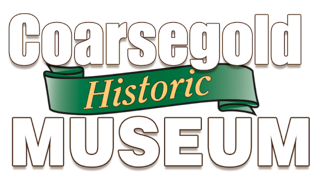Gold Fever
The gold panner exhibit is in the Southwest Corner. The Country Store is on the Southeast Corner. The South Wall between the two is focused on the gold panning and mining activities that occurred in and around the Coarsegold Areas. The Chinese Heritage Display also gives a bit of insight into the work the Chinese laborers had done in the area shortly after the start of the gold rush.
After most of the “easy to get” placer gold was pulled from the creeks and streams the hard rock Quartz mines came into existence. There are plaques that discuss the Quartz mines and pictures that show the Mines and the Towns that magically appeared around them. As stated earlier, Coarsegold is the last remaining gold town in eastern Madera County, the rest have been burned down or dismantled for lumber.
Grub Gulch
One area that had quite a few of these Hard Rock Quartz Mines is Grub Gulch. There were twenty-four mines located within a five-mile radius of this town. The larger mines the town supported are the Gambetta Mine, the Mammoth Mine, the Enterprise Mine, and the Josephine Mine. It is said that the population of Grub Gulch was once 5000 people. When the mines played out and were closed the town disappeared. In 1920 a fire destroyed the whole town. Shortly after the fire there was no visible evidence the town ever existed. The Clampers recently erected a historical marker on road 600 that is between the present-day towns of Ahwahnee and Raymond.
Narbo
Very close to the museum was the mining town of Narbo. The town was located on Quartz Mountain, off Indian Lakes Road and Road 417. A Frenchman had bought the mine, that some say was salted with Colorado gold. He went back to France to get investors, and then built a town and a hotel. The hotel had huge windows that people said appeared to glow like gold to those coming east across the valley at sunset. The French investors often visited the town and stayed at the hotel. It was said to be one of the finest hotels in the area. An effort to get water from the Bass Lake area by building a trench and flume failed. Miller and Lux owned the riparian rights and refused the water. That was the end of Narbo. The town lasted about four years.
Near the floor note the saddle bags that were used by “Hub” McAllister to deliver mail to Narbo. You will also see a Tree Stump. Electricity was brought into the mountains by attaching wire to anything that was available. On the post you will see early electrical insulators that were used.
Chinese Heritage
The Chinese were brought into California to build the railroads. When the railroads were completed some Chinese went back to China, while some came here shortly after the start of the gold rush in 1849. Most of the workers in the large mines near Grub Gulch were Chinese. They were an industrious group of people and did many different types of jobs in the area. One group had a laundry up on Road 600 at Grub Gulch. They were taunted by the miners and kids who threw rocks at their tin roof, but they stayed and continued to launder clothes. The Chinese endured much racial prejudice. The exhibit displays storage jars, a soy sauce jug and utility jug and an abacus. Note the framed tribute to the Chinese railroad workers and an article from the Sierra Star. Also note the cloisonne vases, embroidered hanky, fans, rice bowl and some pictures of residents.
